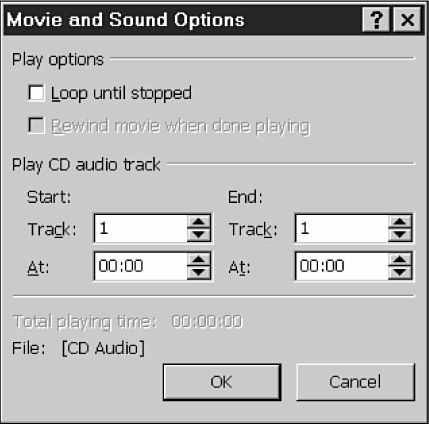Inserting Clips
There are several ways to add clips such as clip art, pictures, photographs, movies, and sound to your PowerPoint presentations. The method you choose depends on where the clip is located (in the Clip Organizer or only on your computer, for example), how you prefer to use PowerPoint, and whether or not you know exactly what you want to insert.
Inserting Clip Art
To insert clip art, you can do any of the following:
From the Slide Layout task pane, choose any of the content layouts and click the Insert Clip Art button from the content palette. The Select Picture dialog box opens (see Figure 13.1), displaying clips from the Clip Organizer.
Figure 13.1. Inserting a clip from a slide layout is just one option.

Select the picture you want to insert and click OK to insert it on your slide. If you want to search for a specific image, enter its keyword in the Search Text field and then click Search.
→ For details on choosing and using layouts, see “Understanding Slide Layouts” in Chapter 2, “Creating a Basic Presentation.”
Note
If you want to import a clip, click the Import button. This opens the Add Clips to Organizer dialog box where you can choose the clip you want to import.
From the Slide Layout task pane, choose either the Title, Clip Art, and Text or Title, Text, and Clip Art layout, and double-click the clip art placeholder to open the Select Picture dialog box.
Choose Insert, Picture, Clip Art to open the Insert Clip Art task pane, shown in Figure 13.2.
Figure 13.2. Search for clip art by keyword.

Search by keyword for the type of clip art you need, and select it. Click the down arrow to the right of the thumbnail and then choose Insert. The clip will be inserted on your slide.
The first time you open the Insert Clip Art task pane, the Add Clips to Organizer dialog box appears. Use this dialog box to have PowerPoint automatically organize your clips for you.
Note
You can also drag your selected picture from the task pane to the slide.
→ To learn more about using the Add Clips to Organizer dialog box, see “Opening the Clip Organizer” in this chapter.
Choose Insert, Picture, Clip Art to open the Insert Clip Art task pane. Click the Clip Organizer link to open the Microsoft Clip Organizer from which you can view clip art collections. Figure 13.3 illustrates the Clip Organizer.
Figure 13.3. Browsing the collections in the Clip Organizer is another way to locate clip art.

Within the Clip Organizer, you can either copy and paste a clip into your PowerPoint presentation, or drag and drop it if your windows are arranged to accommodate this.
Click the Insert Clip Art button on the Drawing toolbar to open the Insert Clip Art task pane. From here, you can either use the task pane's search functionality to search for clip art, or click the Clip Organizer link to go directly to the gallery.
Inserting Pictures
To insert a picture on a slide, do any of the following:
From the Slide Layout task pane, choose any of the content layouts and click the Insert Picture button from the content palette. The Insert Picture dialog box opens (see Figure 13.4), which is similar to the Open dialog box.
Select the picture you want to insert and click Insert to insert it on your slide.
→ To learn more about the advanced features of the Open dialog box that are shared with the Insert Picture dialog box, see “Exploring the Open Dialog Box” in Chapter 2.
Choose Insert, Picture, From File to open the Insert Picture dialog box.
Choose Insert, Picture, From Scanner or Camera to open the Insert Picture from Scanner or Camera dialog box.
Figure 13.4. Locate and insert a picture from this dialog box.

→ To learn more about inserting pictures from scanners or cameras, see “Adding Clips from a Scanner or Camera” in this chapter.
Inserting Sounds or Movies
To insert a media clip (sound or movie file) to your presentation, do any one of the following:
From the Slide Layout task pane, choose any of the content layouts and click the Insert Media Clip button from the content palette. The Select Media Clip dialog box opens, displaying available clips from the Clip Organizer. This dialog box is nearly identical to the Select Picture dialog box; simply choose the clip you want to insert and click OK.
A message box asks if you want to play the file automatically in the slideshow. Click Yes if you do. Otherwise, you need to click the file to play it.
Note
To change how the clip is played, you can choose Slide Show, Action Settings to specify mouse click and mouse over effects. You can set additional play options on the Custom Animation task pane. Access this task pane by choosing Slide Show, Custom Animation.
→ For details on using action settings to animate your presentation, see “Using Action Settings” in Chapter 15, “Working with Animation.”
→ To learn about the advanced options in the Custom Animation dialog box, see “Creating Custom Animations” in Chapter 15.
From the Slide Layout task pane, choose either the Title, Media Clip, and Text or Title, Text, and Media Clip layout, and double-click the media clip placeholder to open the Select Media Clip dialog box.
Choose Insert, Movies and Sounds, Movie from Clip Organizer or Sound from Clip Organizer. The Insert Clip Art task pane opens; select one of the options in the task pane or click the Clip Organizer link to open the Clip Organizer.
Choose Insert, Movies and Sounds, Movie from File or Sound from File. Depending on your selection, either the Insert Movie or Insert Sound dialog box opens, as shown in Figure 13.5.
Figure 13.5. You can insert your own movie or sound file and have it play automatically.

Select the sound or movie you want to insert and click OK. A dialog box asks if you want the clip to play automatically when you display the slide. Click Yes if you want to do this. Otherwise, you need to click the clip to play it.
The clip appears as an icon on your slide. You can move this icon to another part of the slide if you want to.
Choose Insert, Movies and Sound, Record Sound to open the Record Sound dialog box, from which you can record your own sound.
→ To learn how to record your own sound file, see “Recording Sound Files” in this chapter.
Choose Insert, Movies and Sound, Play CD Audio Track to open the Movie and Sound Options dialog box, where you can specify a CD audio track to play during your presentation.
→ For details on inserting CD audio tracks, see “Playing a CD Audio Track” in this chapter.
Note
You can also insert a sound or video file by choosing Insert, Object and choosing the appropriate object from the Insert Object dialog box. This uses the Windows Media Player to play the clip rather than the PowerPoint Player. In general, use this method of inserting a media clip only when PowerPoint doesn't support the clip format you want.
Recording Sound Files
You can record your own sound clips to insert in your PowerPoint presentation. You need to have a microphone and sound card to do this.
Tip from
In addition to adding a sound clip to a single slide, you can record a narration for your entire presentation by choosing Slide Show, Record Narration. Narrating your presentation is particularly effective if you're planning to publish to the Web or create a self-running slideshow (such as for a trade show).
→ To learn how to narrate your presentations, see “Recording a Voice Narration” in Chapter 9, “Presenting a Slideshow.”
To record a sound, follow these steps:
Choose Insert, Movies and Sound, Record Sound to open the Record Sound dialog box, which appears in Figure 13.6.
Figure 13.6. Record a sound to play with a particular slide.

Enter a description for this sound in the Name field.
Click the Record button to begin recording your sound.
Click the Stop button when you finish recording. To play back the sound, click the Play button.
Click OK to save the sound with the presentation; click Cancel to exit and start over.
The sound now appears as an icon in your presentation, and you can use it anywhere in that slideshow. For example, you can play the sound when you click a specific object using PowerPoint's action settings.
→ To learn how to play sounds with action settings, see “Using Action Settings” in Chapter 15.
Playing a CD Audio Track
You can also play a specific audio track from a CD during a PowerPoint presentation. For example, you might want to include music from a CD as a background or to introduce your presentation. To do this, follow these steps:
Choose Insert, Movies and Sound, Play CD Audio Track to open the Movie and Sound Options dialog box, shown in Figure 13.7.
Figure 13.7. Music from a CD can serve as a background sound.

Select the Loop Until Stopped check box if you want the track to play continuously during your presentation.
In the Play CD Audio Track group box, choose the start and end tracks to play.
If you want to play only part of a track, indicate the timespans in the Start At and End At fields. For example, you might want to play only the first two minutes of a track.
Click OK to close.
PowerPoint displays a CD icon on the open slide. These steps insert the CD clip into the slide, but you must use the Custom Animation dialog box to set up your presentation to play this file during the slideshow.
→ For details on setting up custom animation options, see “Creating Custom Animations” in Chapter 15.
